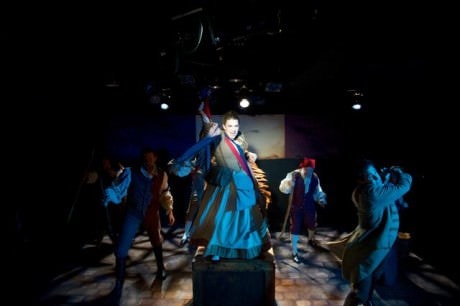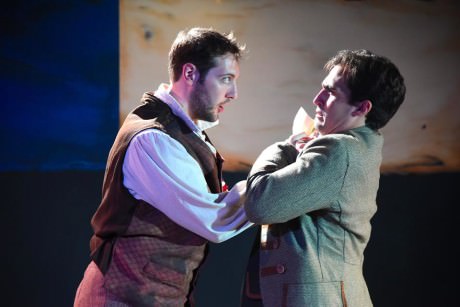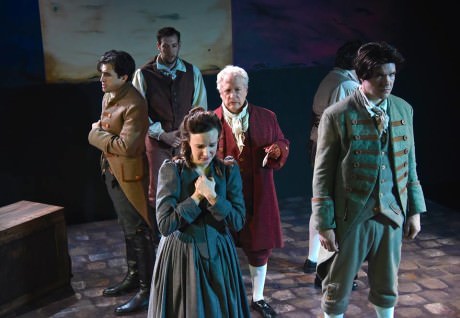This company offers a remarkable show where the space is intimate, the stage direction is well choreographed, and the performances are powerful. Originally adapted by Laura Eason, founding Artistic Director, Sally Boyett is also the Director and choreographer for this production.

Scenic Artist, Marianne Fernandez takes a small space and transforms it that sets a somber mood for a grand production. The floor is painted cobblestone, in varying earth tones accompanied by a wooden trunk that doubles as both low and high tables. There are also a few wooden chairs that are positioned at the edge of the audience seating and then appropriately positioned when needed on stage. The set is meant to be sparse because it is the actors that arouse emotions and bring their characters to life.
The year is 1775, just before the French Revolution. In this production, each cast member has a principle role but also take on multiple roles. French aristocrat by birth, Charles Darnay (Patrick Truhler) now resides in England because he cannot bear the injustices of the French social system. Charles is an honorable man who rejects his Uncle Marquis Evrémonde’s cruelties and honest when he reveals to Doctor Manette (Lucie’s father) his true identity. Additionally, Charles shows courage when he returns to Paris, risking his own life to save the imprisoned Gabelle. Truhler’s gentle features and pleasant tone exuded likability and hope for this character. Truhler also plays a “Jacques Revolutionary,” Marquis St. Evrémonde the first, Man on the Bridge, Barrier Guard #1, Condemned #4, and Ensemble #3.
Alcoholic attorney Sydney Carton (Brian Keith MacDonald), who works with Stryver, is actually annoying at times, which means MacDonald’s drunken mannerisms are quite convincing. As Carton, he has no direction in life. However, his love for Lucie Manette changes him into a man of importance. MacDonald projects empathy for this character and hatred in the role of Marquis Evrémonde, Charles Darnay’s uncle. As a French aristocrat, Evrémonde has no emotion whatsoever and truly wishes that peasants would be exterminated. MacDonald takes on the roles of Bastille Guard, Monsignor, Citizen-Patriot #1, and Revolutionary #2.
Lucie’s Father, Doctor Manette (Richard Pilcher) is an incredibly intelligent physician, who spent eighteen years as a prisoner in the Bastille. Pilcher is adorable in this role as he conquers his prisoner past and is able to become a loving and kind father. When he was imprisoned, Pilcher’s character is somewhat catatonic as he cowers against prison cruelties. When he finally comes back to life and is out of prison, his love for his daughter blossoms. His reason for living moves to a place of love for his daughter and her happiness. Pilcher’s other roles include Gaspard, Waiter, Roger Barsad, Clerk, Gentlemen, Condemned #2, and Ensemble #7.
Lucie Manette (Laura Rocklyn) is a tour de force as a young French woman who grew up in England. She was raised as a ward of Tellson’s Bank because her parents were presumed dead. When Lucie discovers her father is alive but still imprisoned, the emotional turmoil of this character rises to the surface. Rocklyn is a master at anguish in her taut facial expressions, tense body language, and real tears. This gal can cry on cue. This compassion is what keeps her family together in being able to recall her father back to life. Additionally, she helps Sydney Carton to shift from vicious villain to helpful hero. Rocklyn also plays a Peasant Woman, Seamstress, Woman on the Bridge and Ensemble #2.
Owner of a wine shop and revolutionary in the poor section of Saint Antoine in Paris, Monsieur Defarge (Joel Ottenheimer) was a servant to Dr. Manette. Ottenheimer commands the stage with his tall stature and take-charge gestures that is suggestive of Nicolas Cage in National Treasure. Defarge is dedicated to improving society at any cost but he shows thoughtfulness toward Dr. Manette. Ottenheimer also resumes the roles of Attorney General, Bank Man, Gaoler, Barrier Guard #2, Condemned #1 and Ensemble #5.
The other half of this couple is his wife, Madame Defarge (Amy Pastoor) who views her husband’s kindness toward Manette as a flaw. Madame Defarge seethes with hatred and revenge and Pastoor is undeniable engaged to this character. Her boisterous crusading cries, her fierce body language, and obsessive knitting of a register of everyone who must die for the revolutionary cause is flawless. This character is relentless and does not yield to her need for revenge. Pastoor is a driving force in this production and her Dying Woman scene is outstanding. Easily she plays a servant, Condemned #5, and Ensemble #1. Kudos also goes to Pastoor for choreographing the fight scenes.
Gabelle (James Carpenter) is in charge of the Evrémonde estate after the Marquis’ death. Carpenter is convincing as he cowardly hides when he is unable to collect taxes from the peasants. Eventually, revolutionaries imprison him and then he sends a letter to Charles Darnay to travel to France to save him. In the role of Jarvis Lorry, a very business-oriented bachelor at Tellson’s Bank, this character has good moral sense and a good heart. He becomes a loyal friend to Doctor Manette and Lucie thus proving his trustworthiness. Carpenter is also Foulon, Public Prosecutor, Condemned #3 and Ensemble #4.

Lighting Designer, Adman Mendelson sets the dark tone with low lighting and then explosive lighting cues at the on slot of the Revolution. Cleverly, the name of each chapter is projected onto the upstage wall that was painted with a tattered French flag. This show would not be as successful without Mendelson’s talents as well as that of Sound Designer, Gregory Thomas Martin. Martin provides noteworthy sound effects throughout but the gun fire of the revolution is remarkable.
Sally Boyett, a woman of many abilities, coordinated the costumes. The male characters wore 3-piece suits, some wore knee-length knickers with tall socks and slip on black shoes. Their coats were detailed with tan trim around the collar, cuffs, and aligned with the numerous buttons that trailed down the front. Their suits were tan, maroon, and a dark green. Small add-ons like a revolutionary pin or a sash in French flag colors indicted a character change. The gals wore multiple layered dresses that showed their differing social classes. Their dresses were high-collared, with long sleeves and long skirts and presented in dark colors. A shawl or a sash would show their character changes as well.

As the rest of the opening soliloquy goes, it truly embodies what A Tale of Two Cities is all about and a history between France and England that is undeniable.
…it was the age of wisdom, it was the age of foolishness, it was the epoch of belief, it was the epoch of incredulity, it was the season of Light, it was the season of Darkness, it was the spring of hope, it was the winter of despair, we had everything before us, we had nothing before us, we were all going direct to heaven, we were all going direct the other way – in short, the period was so far like the present period, that some of its noisiest authorities insisted on its being received, for good or for evil, in the superlative degree of comparison only.
Even more so, it is a reflection of humanity and what we choose as humans – the kindness of the light or the cruelty of the dark; or the hope of spring or the bitterness of winter. That is what this cast provokes with their powerful and passionate performances. Annapolis Shakespeare Company is a gem near the heart of the Annapolis Design District and this production should be at the top of anyone’s summer theater list.
Running Time: 90 minutes, with one 15-minute intermission.
A Tale of Two Cities plays through August 2, 2015 at ASC Studio 111 – 111 Chinquapin Round Road, Suite 114, in Annapolis, MD. For tickets, call the box office at (410) 415-3513, or purchase them online.




